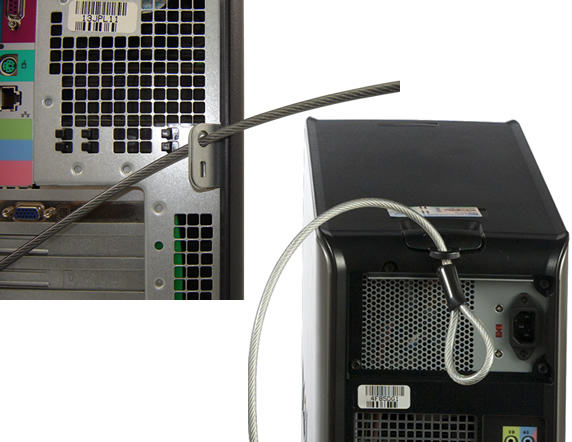| The 'NO FASTENER NEEDED' method.
Some equipment already has a 'built in' way to attach the
cable.

Take a look at your CPU. Does it already have
an external 'hole'? This could be on the top or the back. If
it does, you can run the cable directly through it, eliminating
the need for a fastener. |
| |
|
 Does
your monitor have a stand with a 'built in' opening that you
could run the cable through? The 810 lock style has
a hole in the lock to allow you to form a second loop in the
cable at the lock end, as shown here. The 820 lock style does
not have this hole, so if you choose the 820 lock style, you
can only use this method of attachment if you don't need the
cable's built-in loop to attach to the desk (see step 2). Does
your monitor have a stand with a 'built in' opening that you
could run the cable through? The 810 lock style has
a hole in the lock to allow you to form a second loop in the
cable at the lock end, as shown here. The 820 lock style does
not have this hole, so if you choose the 820 lock style, you
can only use this method of attachment if you don't need the
cable's built-in loop to attach to the desk (see step 2).
WARNING: MAKE SURE the stand is
permanently attached to the monitor, otherwise, this method will
not work. Some monitors detach from the stand with a push of
a button or a couple screws and this would NOT be secure.
|
| |
|
The SCISSOR CLIP fastener method.
This
method uses the built-in security slot that is located in
just about every type of equipment nowadays. This small rectangular
cutout (about 1/4" long) is built into the equipment by the
manufacturer for just this reason. It will sometimes
have a picture of a padlock next to it, and it can be located
just
about anywhere! Each manufacturer and type of equipment has
it located in a different spot! They don't make things easy
sometimes
:).
Take a look at the pictures below to see some of the locations
of the security slot. |
| |
|
 |
These are by no means the only locations these
slots can be, but it gives you an idea of what to look for.
Once you have located the security slot, you can determine
which method is best for security. |
| You
can use external scissor clips (or X-clips as they are sometimes
called). You insert the scissor clip into the security slot,
then run the cable through to keep it closed. |
Or
you can choose the 820 lock style with the scissor clip
directly built in! This works great for the last piece of equipment
you are securing with the cable, and can be much more convenient. |

|
 |
| Most
people need a combination of both types... |
The GLUE-ON
fastener method.
This method permanently glues a fastener onto your equipment. This
is used when there is no security slot or external hole to
run the cable through. This method is also used when you want
a higher level of security than the security slot provides. The
glue-on fastener footprint measures 2 3/4" x 1 1/8" and
is 1" high.
It can withstand over 2,000 lbs. of pull force. |
 |
| Although 90% of all equipment today has a built-in security
slot, including printers, scanners, projectors, flat screen TV's,
etc. there are still some that don't. The glue-on fastener can
be used to secure ANY equipment! (this is a permanent
attachment) |
|


 Does
your monitor have a stand with a 'built in' opening that you
could run the cable through? The 810 lock style has
a hole in the lock to allow you to form a second loop in the
cable at the lock end, as shown here. The 820 lock style does
not have this hole, so if you choose the 820 lock style, you
can only use this method of attachment if you don't need the
cable's built-in loop to attach to the desk (see step 2).
Does
your monitor have a stand with a 'built in' opening that you
could run the cable through? The 810 lock style has
a hole in the lock to allow you to form a second loop in the
cable at the lock end, as shown here. The 820 lock style does
not have this hole, so if you choose the 820 lock style, you
can only use this method of attachment if you don't need the
cable's built-in loop to attach to the desk (see step 2).

